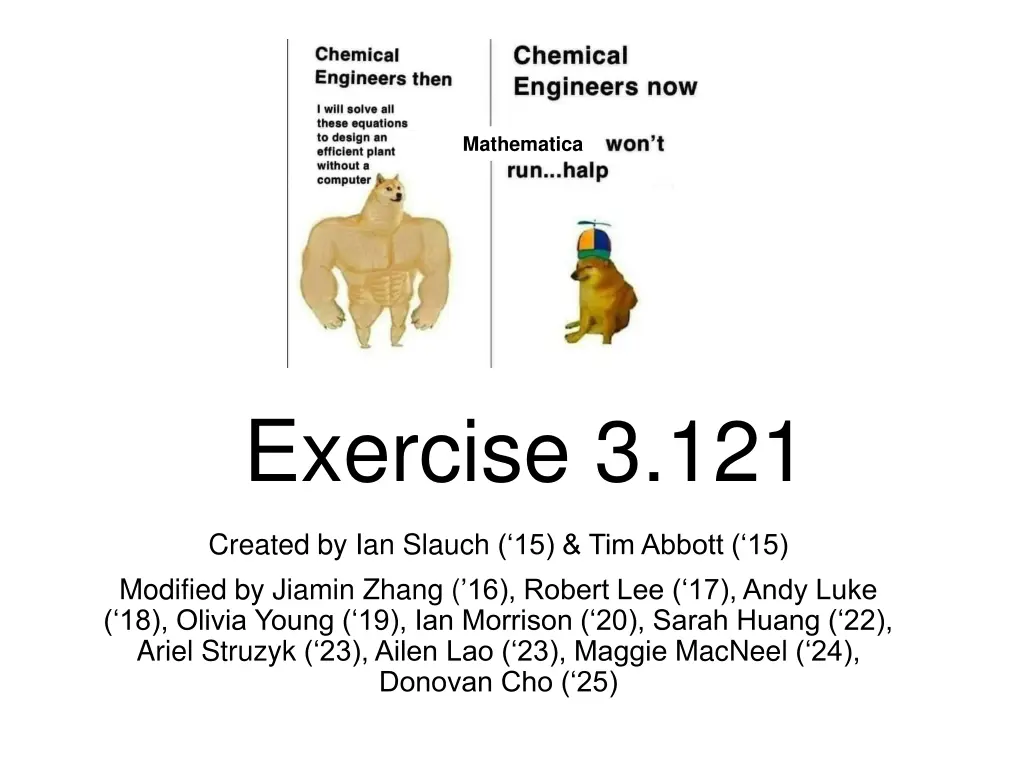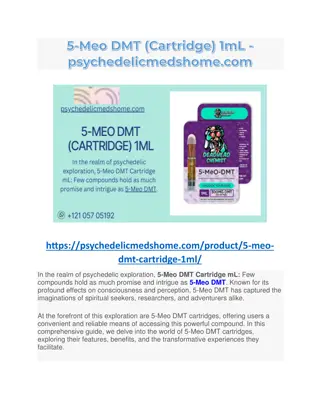
Design Strategy for A Purification Process
Explore a comprehensive design plan for purifying compound A in a chemical engineering process. Learn about reactions, purity levels, goals, and the execution plan involving various components and separators to achieve high-purity A efficiently.
Download Presentation

Please find below an Image/Link to download the presentation.
The content on the website is provided AS IS for your information and personal use only. It may not be sold, licensed, or shared on other websites without obtaining consent from the author. If you encounter any issues during the download, it is possible that the publisher has removed the file from their server.
You are allowed to download the files provided on this website for personal or commercial use, subject to the condition that they are used lawfully. All files are the property of their respective owners.
The content on the website is provided AS IS for your information and personal use only. It may not be sold, licensed, or shared on other websites without obtaining consent from the author.
E N D
Presentation Transcript
Mathematica Exercise 3.121 Created by Ian Slauch ( 15) & Tim Abbott ( 15) Modified by Jiamin Zhang ( 16), Robert Lee ( 17), Andy Luke ( 18), Olivia Young ( 19), Ian Morrison ( 20), Sarah Huang ( 22), Ariel Struzyk ( 23), Ailen Lao ( 23), Maggie MacNeel ( 24), Donovan Cho ( 25)
What do we know? Reactions: B is entirely consumed if R is in excess B + R 2 Z I + R no rxn INERT (mol A) : (mol X) = 5:1 out of a reactor if R is in excess Example: 11 A + 100 R 10 A + 2 X + 99 R A + R 2 X Start with 100 mol of 55% A, 44% B, and 1% I Goal: purify A
What else do we know? Purity (mol% A) $/mol of A Compound Melting pt (oC) Boiling pt (oC) 50% 1 A -27 37 90% 5 B -27 37 97% 10 I -27 37 99% 30 R 65 244 100% 100 X 24 123 Z 77 171 Pure A is much more valuable than impure A We can t separate A, B, or I by phase! How can we purify A?
What are our goals? 1. Maximize revenue from selling [high purity] A 2. Minimize cost of R (what does this really mean?) 3. Minimize number of units 4. Minimize size of each unit HINT: It is possible to produce some A with 100% purity.
What is the Plan? Reactions: What is a consequence of each reaction? B + R 2 Z B is separated from A in the form of Z I + R no rxn I must leave the system somehow A + R 2 X A is converted to X, decreasing purity
What is the Plan? What must we do to start our design? React B with Z to separate from A o Can separate Z from all components, but not B Do not let I accumulate o Keep track of mass balances! Minimize amount of A converted to X
Design 1: Convert B to Z A (50) I (1) R (151) X (10) Z (88) A (50) I (1) A (55) B (44) I (1) R (200) A (55) B (44) I (1) X (10) Z (88) Reactor A + R 2X B + R 2Z Liquid-gas separator 80oC R (151) X (10) Z (88) Liquid-gas separator 200oC R (200) R (151) R (49) R (151) A is 98% pure. Our revenue is 50 mol/min * $10/mol = $500/min purge How can we improve?
Improvement: Recycle X X (11) A (55) I (1) X (11) Z (88) Liquid-gas separator 145oC X (11) Z (88) Z (88) A (55) I (1) R (156) X (11) Z (88) A (55) B (44) I (1) A (55) B (44) I (1) R (200) X (11) Reactor A + R 2X B + R 2Z Liquid-gas separator 80oC R (156) X (11) Z (88) Liquid-gas separator 200oC R (44) R (156) R (156) No A is produced! Still, we make extra 5 mol/min of A at $10/mol. Revenue is now $550/min Pure A is much more valuable. Can we make 100% pure A?
Improvements??? What is a consequence of each reaction? Reactions: B is separated from A in the form of Z B + R 2 Z I must leave the system somehow I + R no rxn A is converted to X, decreasing purity providing opportunity to make pure A A + R 2 X X may be converted back to A
Improvement: Convert X to A separately (55) (1) (151) (10) A I R X Z (88) A I (1) (50) (55) (44) (1) A B I R (200) (55) (44) A B I (1) Reactor A + R 2X B + R 2Z Liquid-gas separator 80oC (5) A (151) (10) R X Z (88) A R X Z (88) (5) (151) (11) R X Z (88) (155) (1) Liquid-gas separator 80oC Reactor 2X A + R R (200) X (1) X Z (88) (1) X Z (88) (1) Liquid-gas separator 145oC R X Z (88) (156) (1) R (44) We have pure A! Revenue is now $1000/min, $500 from each product stream Liquid-gas separator 200oC Z (88) R (156)
How do we get even more pure A? Recycle the A-I stream! What is the problem? We want to minimize the amount of A in the impure stream, while preventing the reactor from becoming too large Purge with 1:1 ratio for A:I
Design 4: Recycle A-I Stream A I A (1) I (1) A I A I R A B I A B I Reactor A + R 2X B + R 2Z Liquid-gas separator 80oC X Z R R X Z R X Z A (54) R (1156) Liquid-gas separator 80oC Reactor 2X A + R A X (11) Z (88) X R X Z X Z R X Z Liquid-gas separator 145oC Liquid-gas separator 200oC purge R R Z R
How to Calculate Flow Rates? (1) (1) A I A I A I A I R X Z Choose to recycle 1:1 with I, then balance around reactions A B I R A (55) B (44) I (1) Reactor A + R 2X B + R 2Z Liquid-gas separator 80oC (88) R X Z R X Z A R Liquid-gas separator 80oC (88) (54) Reactor 2X A + R A (88) X Z (88) X R X Z X Z R X Z Liquid-gas separator 145oC (88) Liquid-gas separator 200oC (88) purge (88) R (44) R (88) Z R
Flow rate of X into reactor: X 54*2 = 11 X = 119 Looking at 2X Recall 5:1 ratio of A:X A + R reactor A I A (1) I (1) A I A I R X Z A B (44) I R A (55) B (44) I (1) Reactor A + R 2X B + R 2Z Liquid-gas separator 80oC (88) R X Z R X Z (54) A R X Z (119) (88) Liquid-gas separator 80oC A (54) Reactor 2X A + R (88) (11) (88) X R X Z X Z R X Z Liquid-gas separator 145oC (88) Liquid-gas separator 200oC (88) purge (88) R R Z (88) R
5:1 ratio of A:X A I A (1) I (1) A I A I R X Z (540) A B (44) I R A (55) B (44) I (1) Reactor A + R 2X B + R 2Z Liquid-gas separator 80oC (108) (88) R X Z R X Z (54) A R X Z (119) (88) (108) (88) Liquid-gas separator 80oC A (54) Reactor 2X A + R (11) (88) (11) X R X Z (11) X Z (11) (88) R X Z Liquid-gas separator 145oC (88) Liquid-gas separator 200oC purge (11) (88) R R Z (88) R
Splitter composition: A and I in 1:1 ratio A I (539) (539) A (1) I (1) (540) (540) A I A I R X Z (540) (540) (594) (44) (540) A B I R A (55) B (44) I (1) Reactor A + R 2X B + R 2Z Liquid-gas separator 80oC (108) (88) R X Z R X Z (54) A R X Z (119) (88) (108) (88) Liquid-gas separator 80oC A (54) Reactor 2X A + R (11) (88) X (11) R X Z X Z (11) (88) (11) (88) R X Z Liquid-gas separator 145oC Liquid-gas separator 200oC purge (11) (88) R R Z (88) R
Put R in excess, track R through process A (539) I (539) I (539) A (539) A (1) I (1) I (1) A (1) A (540) I (540) I (540) A (540) (540) (540) (1102) (108) (88) A I R X Z (594) (44) (540) (1200) A B I R A (55) B (44) I (1) Reactor A + R 2X B + R 2Z Liquid-gas separator 80oC (1102) (119) (88) R X Z R X Z (1102) (108) (88) (54) (1156) (11) (88) A R X Z Liquid-gas separator 80oC A (54) A (54) Reactor 2X A + R X (11) X (11) R X Z (1156) (11) (88) X Z Z X (11) (88) (88) (11) R X R X Z Z Liquid-gas separator 145oC (1156) (11) (88) Liquid-gas separator 200oC purge MAX revenue! ~$5400 (1200) R (44) R Z (88) Z (88) R (1156)
Final note Fraction Purged Mol/hr of A purged Mol/hr through reactor 0.185% 1.0 1380 0.1% 0.55 1840 0.03% 0.17 4180 0.01% 0.055 10840 We could make a bit more A, but our reactor size goes to infinity. Process design is a balance!
Key Takeaways 1. Use differences in reactivity to separate inseparable components 2. ALWAYS read the given information thoroughly and use the hints producing pure A is possible by turning the X back to A. 3. Almost all the A can be recovered in a pure form by recycling the A and I, but purging can present challenges. 4. Excess usually means more than double the sum of other reactants in the input stream. 5. Think about what each reaction can do for you, how does it contribute to your overall goal?
Calculation Session 5 Exercise 3.121 process design with approximate flow rates. Hint: Some A must leave with I. How to minimize the A lost in the I purge? Exercise 3.64 Consider drawing an equivalent unit that comprises units with elementary energy changes. Exercise 3.68 Sketch the heat exchanger. Professional Development, Part 3: creating a LinkedIn page. Homework questions? Ask!





















